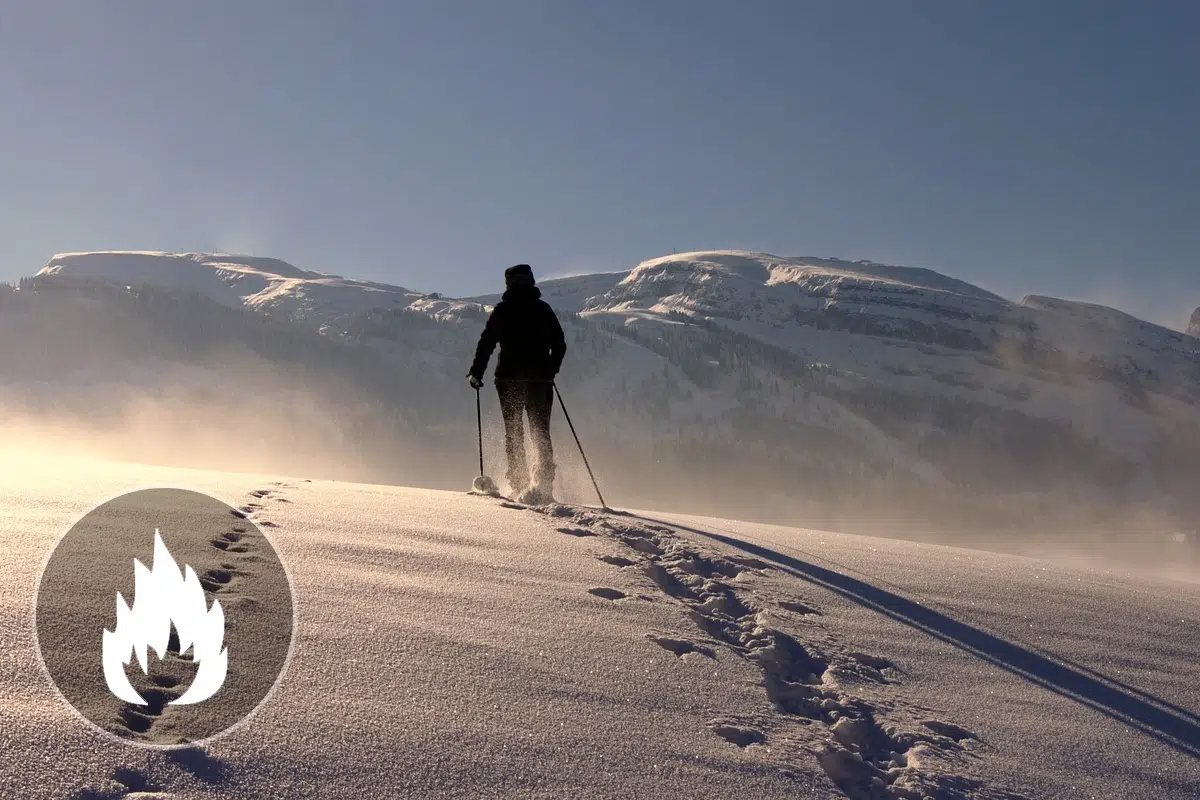Show summary Hide summary
How many calories does snowshoeing burn?

Everything you need to know about snowshoeing
Want to know how many calories you’re burning snowshoeing or hiking through snow for 30 minutes, 1 hour or a full day? Enter your info and let our tool do the rest.
Snowshoeing: examples of calorie expenditure according to weight and activity time.
Use the table below to see how many calories you can burn snowshoeing!
Snowshoeing
Moderate intensity
Expenditure in Kilocalories
| Weight | 15 minutes | 30 minutes | 1 hour |
|---|---|---|---|
| 40 kg | 84 | 168 | 336 |
| 50 kg | 105 | 210 | 420 |
| 60 kg | 126 | 252 | 504 |
| 70 kg | 147 | 294 | 588 |
| 80 kg | 168 | 336 | 672 |
| 90 kg | 189 | 378 | 756 |
See detailed calculations and metabolic equivalent for snowshoeing
Everything you need to know about snowshoeing
FIND OUT MORE ABOUT SNOWSHOEING
Snowshoeing is a great way to burn off energy while enjoying the beauty of the mountains.
Many groups set off in search of wildlife, trying to spot the tracks in the snow of the local inhabitants. In short, snowshoeing is an excellent way to lose weight and have fun at the same time.
Snowshoeing offers a unique experience, allowing you to explore snow-covered landscapes, enjoy nature and take part in outdoor physical activity.
Here are just a few of the benefits of snowshoeing:
- Complete physical activity: Snowshoeing involves the whole body, as it requires constant effort to move forward on the snow. This works the muscles of the legs, buttocks, trunk and arms, providing a complete workout.
- Muscle strengthening: Walking or running with snowshoes helps to strengthen these muscles and improve their tone and endurance.
- Cardio-training: Snowshoeing is a cardiovascular activity that increases heart rate and stimulates blood circulation. This helps improve cardiorespiratory endurance and strengthen the cardiovascular system.
- Burning calories: Snowshoeing is a high-energy activity that burns a significant number of calories. Depending on the intensity and duration of the activity, you can burn up to 600 calories per hour.
- Improved balance and stability: Walking or running on snow with snowshoes stimulates the stabilizing muscles, helping to improve the body’s balance and stability. This can have a positive impact on other physical activities and reduce the risk of injury.
- Relaxation and well-being: Snowshoeing offers the opportunity to enjoy nature and breathe fresh air in the middle of winter. This can have beneficial effects on morale, reduce stress and promote general well-being.
In conclusion, snowshoeing is a winter activity that offers a complete outdoor physical activity. It offers numerous fitness benefits, including muscle strengthening, improved cardiovascular endurance, calorie burning, improved balance and stability, as well as relaxation and well-being. Whether you’re a beginner or an experienced snowshoer, snowshoeing is a great way to enjoy the winter while keeping fit.
Calculation method for snowshoeing
The result displayed is expressed in Kcal and is calculated from the MET (Metabolic Equivalent of Task). The MET for each activity is the result of statistical data and cannot therefore be interpreted as an exact calculation, but rather as an estimate taking into account the MET value and the ratio between the time spent on an activity and the weight of the individual.
For example: the MET value for snowshoeing is 8. This means that a person walking in powder snow with snowshoes consumes 8 times more energy than when at rest.
The detailed calculation formula for snowshoeing
Consumption in Kcal per minute = (MET*3.5*Weight in kilos)/200
For a 70-kilo person swimming a moderate stroke for 4 hours, i.e. 240 minutes:
Consumption in Kcal per minute = (8*3.5*70)/200 = 9.8 Kcal/mn
So for 30 minutes = 9.8*240 = 2352 kcal for 240 minutes, i.e. 4 hours of walking
All sports in detail!



















































